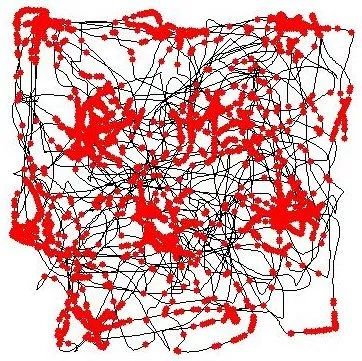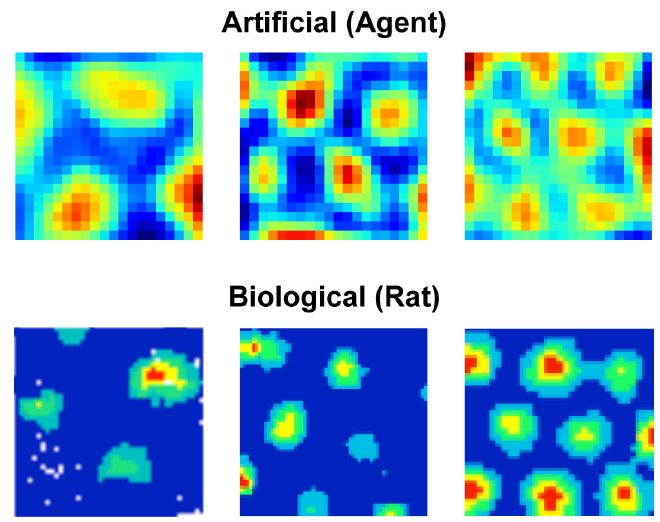On May 9th, Eastern Europe, Nature Online released the developers of the British Deep Mind team, Alpha Dog and Alpha Dollar, and a collaboration paper with University College London (UCL) titled Vector-based navigation using grid-like. The representations in artificial agents have caused a stir in the fields of neuroscience and artificial intelligence.

Behind this highly abstract thesis topic, what is implied is the fact that AI has already settled grid cells for humans. This nature has evolved through millions of years of life.
The thesis studies seemingly simple yet profound questions: Where are we and where will we go? This very philosophical proposition, Kant, the great philosopher more than 200 years ago, has already thought about it. He believes that people’s perception of space is a priori. The biological interpretation of this problem was only clear in 2005. It was the so-called grid cell discovered by the couples of May-Britt Moser and Edvard Moser. The behavior of grid cells was so shocking that the Moser couple shared the Nobel Prize in Physiology in 2014.

Although animals are more than adequate in natural spaces, their cognitive and computational basis is not clear. For AI, judging their position and deciding the path of walking is even more difficult. There was no good solution before. Although Alpha is able to handle the human race easily in the grid of Go. But when AI discovered a pattern similar to that of a biological grid cell, everything became different. Grid cell finder Edvard Moser said:
This paper came out of the blue, like a shot, and it's very exciting. It is striking that the computer model, coming from a totally different perspective, ended up with the grid pattern we know from biology.
Neuroscientists Francesco Savelli and James Knierim of Johns Hopkins University in the same period published a news commentary titled AI mimics brain codes for navigation.
It is interesting that the network, starting from very general computational assumptions that do not take into account specific biological mechanisms, found a solution to path integration that seems similar to the brain's. That the network converged such a solution iscompelling evidencethat there is something special About grid cells' activity patterns that supports path integration.
Grid cells
The perception of location and cruising ability in space are undoubtedly vital to life. At the end of the 1960s, UCL neurophysiologist John O'Keefe began to study this problem, and in 1971 found the Place Cell, the first component of the brain positioning system. O'Keefe discovered that when experimental rats are in a specific location, a group of nerve cells in the brain's hippocampus are activated. This answers the question “Where am I?†and O'Keefe shared the 2014 Nobel Prize in physiology with the Moser couple. It needs to be pointed out that the location cells are merely sensory experiences marked at different locations in space and are permanently remembered by the hippocampus. But the location cells are not coordinates and they do not have the ability to calculate geometry.

In 2005, the Moser couple discovered the more mysterious grid cells in the entorhinal cortex. They recorded the regular activation of specific nerve cells during exercise in rats and found the above image, in which the black line is the trajectory, and the red dot is the record of the corresponding cell activation at that position. After statistical denoising, the pattern is this, showing a regular six-way arrangement!

This is really an immortal masterpiece of nature! Whether you are a biologist, mathematician, physicist, or philosopher, you must not admire such magic and elegance!
The grid cell information function is very rich, and it answers the core questions of spatial intelligence. In the positioning process, the rats are divided into equilateral triangles, positioned according to the distance from the three vertices of the triangle, and can integrate their own trajectory points on the map! Euclid geometry, vector algebra, and numerical integration are deeply embedded in our genes!
artificial intelligence
After billions of years of evolution, nature has developed such a simple and elegant positioning and cruising system. Although artificial intelligence can easily overcome humans on the chessboard, its cognitive and cruising capabilities in space are still far inferior to those of biology. On the other hand, although people speculate that grid cells support vector cruising of organisms, that is, calculate the distance and direction to the target, the relationship between computing functions and vector cruising after more than ten years of discovery of grid cells Still unknown. Deep Mind's paper today answers these two questions to some extent.
Deepmisd founder and CEO, co-author of the paper Demis Hassabis said:
The human brain is the only existence proof we have that the sort of general intelligence we're trying to build is even possible, so it makes sense to look to neuroscience as a source of inspiration for new types of algorithms. But we believe that this inspiration should Be atwo-way street, with insights also flowing back from AI research to shed light on open questions in neuroscience.
In this work, researchers first trained a recurrent neural network to locate in a virtual environment based on motion velocity information. This is very similar to the information used by mammals to locate locomotion in unfamiliar environments. What is shocking is that similar grid cell patterns, which researchers call grid cells, appear naturally in neural networks, as shown above! The positioning scheme of artificial intelligence is highly consistent with the answers obtained by the evolution of millions of years in nature!

What is even more amazing is that the researchers found that the neural network with grid cells, after intensified training, was able to look for shortcuts like animals and had superhuman cruising ability, easily surpassing professional players in virtual reality games. If the grid unit is muted, its cruising ability is greatly reduced, and the calculation errors of distance and direction are increased, which proves the importance of grid mode to vector cruising.
The researchers said that this work is not only an important step to understand grid computing functions, but also an important step in the development of artificial intelligence, showing the importance of brain-like machine learning framework. The same method can also be used to study other perceptions of life.
According to Dr. Liu Fangde, the British Imperial College of Technology, the study of positional cells and grid cells is inspiring for artificial intelligence, especially robot systems. The location cell is actually a spatially indexed database that describes the topological space, while the grid cell is a geometric calculator and depicts Euclidean space. This kind of organization is completely different from our current technology in computer science and has a very strong advantage.
Prof. Chen Yiran and Ph.D. student Wu Chunpeng from Duke University explained that the two details mentioned in the paper are worth noting. First, if the loss function of the neural network does not include regular terms, the neural network cannot exhibit grid cell functions. This discovery gave us a fresh perspective on the role of regular terms. Second, the paper points out that the “black box†feature of deep neural networks hinders the further analysis of grid cell activity characteristics on path integration. This again confirms the need to study the interpretability of neural networks.
Indeed, Francesco Savelli and James J. Knierim emphasized in the news review:
The fact that the grid representation enhanced goal-directed performance is acompelling proof-of-concept of the role of grid cells in the brain. But the inability to directly affect these calculations in the model makes it difficult to examine the computational principles, algorithms and encoding Strategies that make grid-cell representations of space such an efficient solution for navigation... Making deep-learning systems more intelligible to human reasoning is an exciting challenge for the future.
In this regard, the paper co-first and correspondence author Andrea Banino said
In the future, if we could improve these artificialmodels, we could potentially use them to understand other brain functionalities. This would be a giant step toward the future of brainunderstanding.
It seems that the era of AI's scientific research is already approaching. Do professors and postgraduates need to work overtime? You think, you might as well leave a message and share with everyone.
With Yuchai Engine Diesel Generator
With Yuchai Engine Diesel Generator,Yuchai Diesel Generator,Yuchai Diesel Generator Set,Yuchai Generator
Shanghai Kosta Electric Co., Ltd. , https://www.ksdgenerator.com